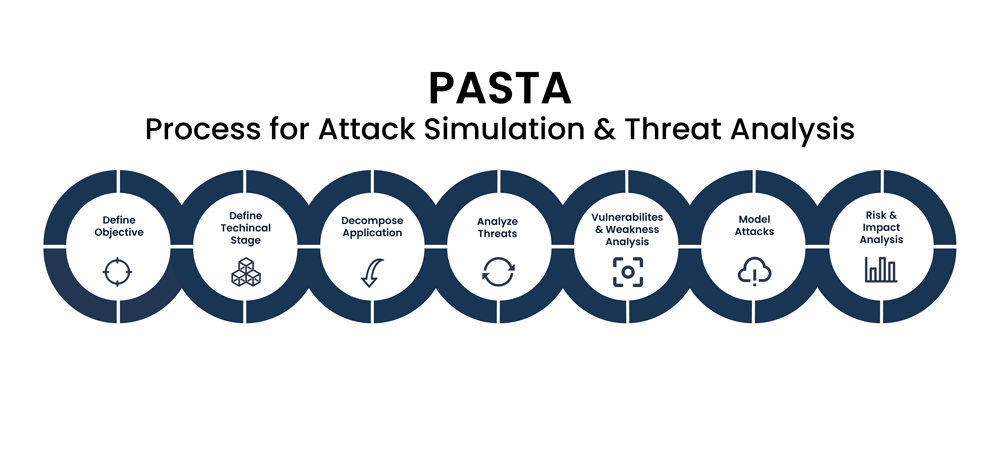
Status: Final Blueprint
Author: Shahab Al Yamin Chawdhury
Organization: Principal Architect & Consultant Group
Research Date: June 11, 2025
Location: Dhaka, Bangladesh
Version: 1.0
1. Executive Summary
This document outlines the PASTA-SOC framework, a structured methodology to evolve a Security Operations Center (SOC) from a reactive to a proactive, threat-informed defense model. It operationalizes the seven stages of the Process for Attack Simulation and Threat Analysis (PASTA) by integrating its business-centric principles with the tactical capabilities of modern security technologies, primarily Breach and Attack Simulation (BAS), Threat Intelligence Platforms (TIPs), and Security Orchestration, Automation, and Response (SOAR).
The framework facilitates a shift from periodic, manual security tests to a continuous, automated validation of security controls against real-world adversary tactics, techniques, and procedures (TTPs). This provides an evidence-based, quantifiable understanding of the organization’s security posture, enabling data-driven investments and a demonstrable reduction in cyber risk.
2. Core Principles of the PASTA-SOC Framework
The framework is built on four foundational principles that guide its implementation and operation:
- Business Impact Centricity: Every simulation and remediation effort must be directly traceable to a defined business objective and potential impact, ensuring resources are focused on mitigating tangible risks.
- Adversary-Centric Emulation: Simulations are based on the observed behaviors of real-world adversaries, leveraging frameworks like MITRE ATT&CK to test against credible, relevant threats.
- Evidence-Based Validation: Assumptions about security control effectiveness are replaced with empirical, machine-generated data that proves whether controls can prevent, detect, and generate actionable alerts.
- Continuous Improvement (Purple Team Ethos): The framework operates as a continuous feedback loop where offensive simulations (Red Team) are used to directly inform and improve defensive capabilities (Blue Team).
3. The PASTA-SOC Operational Process: A Seven-Stage Blueprint
The core of the framework is a seven-stage operational process that adapts the PASTA methodology for a live SOC environment.
- Stage I: Define Business & Security Objectives
- Objective: Anchor all technical work in business context by identifying critical functions, conducting a Business Impact Analysis (BIA), and defining clear security and compliance objectives.
- Stage II: Define Technical Scope & Attack Surface
- Objective: Translate business objectives into a defined set of technical assets, systems, and boundaries for testing, including asset inventory and data flow diagramming.
- Stage III: Decompose Application & Infrastructure
- Objective: Analyze the in-scope systems to understand their components, trust boundaries, entry/exit points, and existing security controls.
- Stage IV: Threat Analysis & Intelligence Curation
- Objective: Identify relevant adversaries and their TTPs by leveraging threat intelligence and mapping it to the MITRE ATT&CK framework to prioritize simulation scenarios.
- Stage V: Vulnerability & Weakness Correlation
- Objective: Connect prioritized external threats with known internal weaknesses, such as unpatched vulnerabilities or system misconfigurations, often visualized using attack trees.
- Stage VI: Attack Simulation & Emulation
- Objective: Execute prioritized attack scenarios using a BAS platform to empirically and safely test the effectiveness of the security control stack.
- Stage VII: Risk, Impact, and Control Gap Analysis
- Objective: Analyze simulation results to identify specific control gaps (prevention, detection, or process failures), quantify the associated business risk, and generate actionable remediation recommendations.
4. Governance and Strategic Alignment
Effective implementation requires a strong governance structure to ensure strategic alignment and accountability.
- Cybersecurity Governance Model: The framework’s outputs provide tangible evidence to support governance functions, particularly aligning with the NIST Cybersecurity Framework (CSF) 2.0’s “Govern” function. A formal charter and integration with the enterprise risk management (ERM) program are essential.
- Roles and Responsibilities (RACI): A detailed RACI matrix is crucial for defining clear roles (e.g., SOC Manager, Threat Intel Analyst, Security Engineer, Threat Hunter) and ensuring accountability across the seven stages.
- Compliance Mapping: Simulations should be tagged with the specific regulatory controls they test (e.g., PCI-DSS, HIPAA) to provide auditable evidence of continuous compliance validation.
5. Enabling Technologies: An Integrated Ecosystem
The framework relies on a tightly integrated technology stack to automate the validation lifecycle.
- Breach and Attack Simulation (BAS): The “offensive engine” that executes automated, safe attack scenarios to test control efficacy.
- Threat Intelligence Platform (TIP): The source of truth for adversary TTPs, feeding prioritized intelligence into the BAS platform.
- SIEM / XDR: The “defensive sensor grid” that collects telemetry and alerts on the simulated activities.
- Security Orchestration, Automation, and Response (SOAR): The “connective tissue” that automates workflows, from ticketing control gaps to triggering re-tests for remediation validation.
6. Performance, Maturity, and Value Realization
The program’s success must be measured and communicated in business terms.
- Key Performance Indicators (KPIs): A dashboard of metrics is used to track performance across security control efficacy (Prevention/Detection Rate), operational efficiency (MTTR), and risk reduction.
- Maturity Model: A five-level maturity model, inspired by frameworks like C2M2, provides a roadmap for continuous improvement across people, process, and technology.
- TCO and ROI: A Total Cost of Ownership (TCO) analysis captures all program costs. The value is demonstrated through a Return on Security Investment (ROSI) calculation, which quantifies avoided losses based on data-driven risk mitigation rates.
7. Implementation and Strategic Considerations
A phased 18-month roadmap is recommended for implementation, moving from a foundational pilot to a fully optimized and automated program. Success requires adopting an Agile SecOps culture that fosters collaboration, iterative cycles, and continuous feedback. Organizations must proactively plan for challenges such as resource constraints, technical complexity, and alert fatigue.
Chat for Professional Consultancy Services
